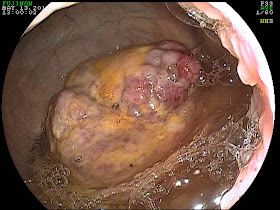A 12 year-old show jumper mare presented to PHD veterinary services for the history of recurring forelimb lameness. In the past 2 years, the mare had the left front coffin joint treated with corticosteroids and hyaluronic acid every 6 months. However, the most recent treatment with intra-articular corticosteroids did not result in resolution of the lameness. On presentation, the mare was a grade 3/5 lame in the left front. The lameness was most evident when trotting on firm ground and in a circle to the right. The mare was NOT positive to hoof tester exam and was mildly positive to lower limb flexion. The coffin joint was "blocked" with carbocain and the mare's lameness improved by >85%. Radiographic exam of the left front foot only revealed evidence of mild osteoarthritis of the coffin joint. (Figure 1).
 |
| Figure 1 |
Due to the following factors: 1) a history of poor response to intra-articular therapy, 2) a positive response to blocking the coffin joint, and 3) minimal data via the radiographic exam, it was recommended that the distal forelimb of this mare be evaluated via magnetic resonance imaging (MRI). The MRI exam requires general anesthesia and generally costs between $1800-$2000; however the information gathered from an MRI exam is far superior than any other type of diagnostic exam! As such, I strongly recommend considering an MRI exam in cases that the CAUSE for the lameness has not been determined and a reasonable attempt has been made to treat and/or diagnose the problem. Figures 2-4 includes several images from the MRI exam involving this show jumper mare. A small, blue circle is included in each image to high light the large articular cartilage and subchondral bone defect that was discovered through the MRI study. In each image, the lesion appears as a small black circle at the surface of the bone. In addition to this finding, the MRI study noted additional evidence of chronic degeneration of the coffin joint. The full extent of the degeneration and the cartilage damage was NOT evident in the radiographic exam!!
 |
| Figure 2 |
 |
| Figure 3 |
 |
| Figure 4 |
Although the prognosis was poor for return to soundness, the mare was treated aggressively with various regenerative therapies and extended rest. Unfortunately, the mare remained significantly lame and it was determined that humane euthanasia was the best option due to the relentless foot pain. A post-mortom exam was performed and a very large area of abnormal cartilage loss (blue circle in Figure 5) was noted that corresponded to the MRI findings. This case represents yet another exam of the importance for getting an answer as to WHAT is causing the problem such that a prognosis can be provided followed by a proper course of action.
 |
| Figure 5 |
In the state of Florida, the most sensitive MRI for imaging in horses is ONLY available at the University of Florida's College of Veterinary Medicine. In addition, the board certified radiologists at the Veterinary College of Veterinary Medicine are especially well trained for the evaluation of MRI studies in horses! For more information about their services please go to:
http://largeanimal.vethospitals.ufl.edu/services/diagnostic-imaging/















